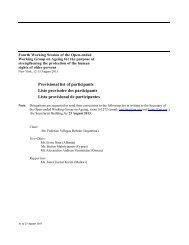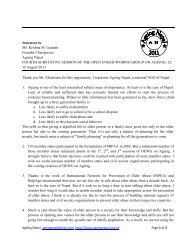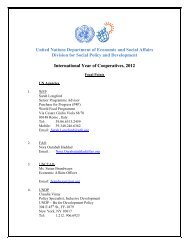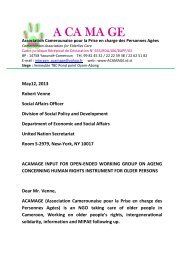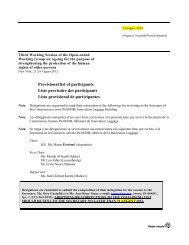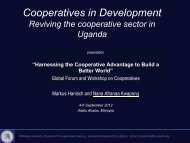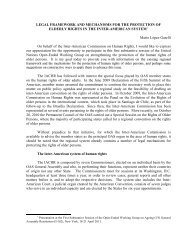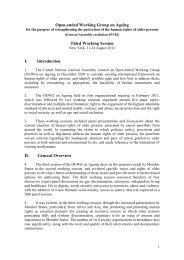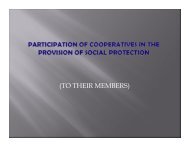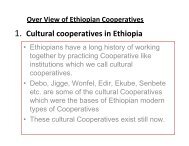contributing to inclusive development: the role of co-operatives
contributing to inclusive development: the role of co-operatives
contributing to inclusive development: the role of co-operatives
Create successful ePaper yourself
Turn your PDF publications into a flip-book with our unique Google optimized e-Paper software.
CONTRIBUTING TO INCLUSIVE DEVELOPMENT: THE ROLE OF CO‐OPERATIVESJo‐Anne Ferguson, Canadian Co‐operative AssociationPresented <strong>to</strong>: Harnessing <strong>the</strong> Co‐operative Advantage <strong>to</strong> Build a Better World,September 4‐6, 2012INTRODUCTION______________________________________________________________Thank you for <strong>the</strong> opportunity <strong>of</strong> sharing views on this important <strong>to</strong>pic. While preparing <strong>the</strong>seremarks, I searched for a definition <strong>of</strong> inclusion and found <strong>the</strong> following: “social inclusion is <strong>the</strong>process by which efforts are made <strong>to</strong> ensure equal opportunities ‐ that everyone, regardless <strong>of</strong><strong>the</strong>ir background, can achieve <strong>the</strong>ir full potential in life.” And “that creating a society for all is amoral obligation one that must reflect <strong>the</strong> <strong>co</strong>mmitments <strong>to</strong> upholding fundamental humanrights and principles <strong>of</strong> equality and equity. There are also strong instrumental reasons forpromoting social integration and inclusion. Deep disparities, based on unequal distribution <strong>of</strong>wealth and/or differences in people’s backgrounds, reduce social mobility and ultimately exerta negative impact on growth, productivity and well‐being <strong>of</strong> society as a whole. Promotingsocial integration and inclusion will create a society that is safer, more stable and more just essential <strong>co</strong>nditions for sustainable e<strong>co</strong>nomic growth and <strong>development</strong>.”In keeping with <strong>the</strong>se ideas, for many <strong>co</strong>mmunities and populations around <strong>the</strong> world, <strong>co</strong><strong>operatives</strong>are <strong>the</strong> best hope for sustainable <strong>development</strong>.While <strong>co</strong>‐<strong>operatives</strong> are not formed for <strong>the</strong> explicit purpose <strong>of</strong> including all segments <strong>of</strong> <strong>the</strong><strong>co</strong>mmunity, <strong>the</strong>y are established by <strong>the</strong>ir members <strong>to</strong> achieve goals that can best be met<strong>co</strong>llectively. In serving <strong>the</strong> needs <strong>of</strong> <strong>the</strong>ir members <strong>co</strong>‐<strong>operatives</strong> play an important and<strong>inclusive</strong> <strong>role</strong> in <strong>development</strong>:• Co‐<strong>operatives</strong> operate as businesses, with long term goals and lasting sustainability.They operate with a distinct, unique perspective based on <strong>the</strong> seven <strong>co</strong>‐operativeprinciples. To remain viable <strong>the</strong> <strong>co</strong>‐operative business must support and grow with <strong>the</strong><strong>co</strong>mmunity it serves. Attention is paid <strong>to</strong> including populations that may o<strong>the</strong>rwise beexcluded.• Co‐<strong>operatives</strong> stimulate <strong>development</strong> within <strong>the</strong> <strong>co</strong>mmunity. This is particularly true forfinancial <strong>co</strong>‐<strong>operatives</strong> that are <strong>the</strong> e<strong>co</strong>nomic genera<strong>to</strong>r for micro‐ and small businessesworldwide.• Co‐<strong>operatives</strong> can be an excellent vehicle for those who are excluded <strong>to</strong> build <strong>the</strong>ir ownviable enterprise.I’ll give examples <strong>of</strong> each <strong>of</strong> <strong>the</strong>se. First, let me introduce <strong>the</strong> Canadian Co‐operativeAssociation and our work which is <strong>the</strong> basis <strong>of</strong> <strong>the</strong>se ideas.Page | 1
The Canadian Co‐operative Association is a national association for <strong>co</strong>‐<strong>operatives</strong> in Canada,representing more than nine million <strong>co</strong>‐operative members from over 2,000 organizations.Individual <strong>co</strong>‐op members are represented in CCA ei<strong>the</strong>r directly through <strong>the</strong>ir <strong>co</strong>‐<strong>operatives</strong>,through <strong>the</strong>ir provincial <strong>co</strong>‐operative associations or through sec<strong>to</strong>ral organizations. CCA isitself a federally‐in<strong>co</strong>rporated <strong>co</strong>‐operative, owned by its 43 member organizations.The mission <strong>of</strong> <strong>the</strong> Canadian Co‐operative Association is <strong>to</strong> provide leadership <strong>to</strong> promote,develop and unite <strong>co</strong>‐<strong>operatives</strong> and credit unions for <strong>the</strong> benefit <strong>of</strong> people in Canada andaround <strong>the</strong> world. CCA’s members <strong>co</strong>me from many sec<strong>to</strong>rs <strong>of</strong> <strong>the</strong> e<strong>co</strong>nomy, including finance,insurance, agri‐food and supply, wholesale and retail, housing, health, and <strong>the</strong> service sec<strong>to</strong>r.CCA's members envision a world where people everywhere thrive e<strong>co</strong>nomically, culturally andsocially. For more than 40 years, CCA’s international <strong>development</strong> program has helped reducepoverty by establishing and growing <strong>co</strong>‐<strong>operatives</strong>, credit unions and <strong>co</strong>mmunity basedorganizations.CO‐OPS AS SUSTAINABLE BUSINESSES____________________________________________Co‐<strong>operatives</strong> re<strong>co</strong>gnize that success is based on <strong>the</strong> long‐term social and e<strong>co</strong>nomic<strong>development</strong> <strong>of</strong> <strong>the</strong> entire <strong>co</strong>mmunity. The members benefit by including segments <strong>of</strong> <strong>the</strong><strong>co</strong>mmunity that have been excluded in <strong>the</strong> past: e.g. women, youth, new immigrants, <strong>the</strong>disabled and o<strong>the</strong>r ethnic groups. The <strong>co</strong>‐operative principles <strong>of</strong> open membership, democraticmember <strong>co</strong>ntrol, member e<strong>co</strong>nomic participation, member education and <strong>co</strong>ncern for<strong>co</strong>mmunity forms <strong>the</strong> basis <strong>of</strong> inclusion.VanCity Credit Union, <strong>the</strong> se<strong>co</strong>nd largest au<strong>to</strong>nomous credit union in <strong>the</strong> world, with over420,000 members and $15,726,674,707 in assets, re<strong>co</strong>gnized <strong>the</strong> need for inclusion and, in2008, opened a branch in East Van<strong>co</strong>uver which is a <strong>co</strong>mmunity known for its at‐risk population<strong>of</strong> people with a his<strong>to</strong>ry <strong>of</strong> al<strong>co</strong>hol and drug use and mental illness and prostitution. They no<strong>to</strong>nly opened a branch, but <strong>the</strong> staff is from this troubled population. Although this branch willnever be a pr<strong>of</strong>it centre for <strong>the</strong> credit union, many people with troubled lives have re<strong>co</strong>veredhope, stabilized <strong>the</strong>ir lives, improved self‐esteem and are supporting <strong>the</strong>mselves. Vancity’smotivation is <strong>the</strong> <strong>co</strong>‐operative principle <strong>of</strong> Concern for Community.Affinity Credit Union, located in Saskatchewan, where many <strong>of</strong> Canada’s Indigenous people livein poverty on rural Reserves, has opened several branches on <strong>the</strong>se Reserves, delivers financialliteracy training and is supporting <strong>the</strong> start up <strong>of</strong> micro and small business. They have aparticular target <strong>of</strong> youth employment. The principle <strong>of</strong> Concern for Community is active here.Page | 2
Co‐<strong>operatives</strong> in almost every province <strong>of</strong> Canada sponsor youth leadership programs <strong>to</strong> orientyouth <strong>to</strong> <strong>co</strong>‐<strong>operatives</strong>, social justice and <strong>co</strong>mmunity <strong>development</strong>. The skills <strong>of</strong> <strong>the</strong>se youth arebuilding <strong>co</strong>mmunities.Agricultural <strong>co</strong>‐<strong>operatives</strong> in Aceh re<strong>co</strong>gnize <strong>the</strong> need for both women and men in leadershippositions and have adopted member gender sensitivity training as a prerequisite formembership. This streng<strong>the</strong>ns <strong>the</strong> viability <strong>of</strong> <strong>the</strong> <strong>co</strong>‐operative and ensures benefits impact <strong>the</strong><strong>co</strong>mmunity.In Nepal women‐only credit unions are helping women <strong>to</strong> change <strong>the</strong>ir lives and <strong>the</strong> lives <strong>of</strong><strong>the</strong>ir families. This e<strong>co</strong>nomic empowerment is assisting women <strong>to</strong> start micro‐businesses,bringing <strong>the</strong>m directly <strong>to</strong> <strong>the</strong> markets where <strong>the</strong>y are opening stalls and changing genderdynamics <strong>of</strong> <strong>the</strong> markets.In Canada, ethnocultural and immigrant <strong>co</strong>mmunities have organized some 73 <strong>co</strong>‐<strong>operatives</strong>and credit unions <strong>to</strong> ensure that members have a fair opportunity <strong>to</strong> meet <strong>the</strong>ir social ande<strong>co</strong>nomic needs. Thirty per cent <strong>of</strong> <strong>the</strong>se are in <strong>the</strong> planning stage, indicating an increasedinterest in ethnocultural and immigrant <strong>co</strong>‐<strong>operatives</strong> in recent years. Co‐<strong>operatives</strong> are alsoused by many <strong>co</strong>mmunities as a means <strong>to</strong> preserve <strong>the</strong>ir diversity in Canada’s multiculturalsociety.CO‐OPS AS ECONOMIC GENERATORS IN THE COMMUNITY___________________________Canadian credit unions have a re<strong>co</strong>gnized strength in serving small businesses which are <strong>the</strong>foundation <strong>of</strong> Canada’s e<strong>co</strong>nomy. For <strong>the</strong> se<strong>co</strong>nd year in a row, <strong>the</strong>y received an award from<strong>the</strong> Small Business Association for <strong>the</strong>ir attention <strong>to</strong> serving this important sec<strong>to</strong>r.As in many <strong>co</strong>untries, Canada is facing urbanization. Young people leave farming and rural<strong>co</strong>mmunities in search <strong>of</strong> employment and, as people age, <strong>the</strong>y move <strong>to</strong> cities <strong>to</strong> access healthcare and <strong>to</strong> be closer <strong>to</strong> <strong>the</strong>ir children. In spite <strong>of</strong> this trend many <strong>co</strong>mmunities are able <strong>to</strong>stabilize and are retaining <strong>the</strong>ir services. Credit unions are important <strong>to</strong> this <strong>development</strong>. Inmore than 1,000 <strong>co</strong>mmunities, credit unions are <strong>the</strong> only financial service in <strong>the</strong> <strong>co</strong>mmunity.Banks have disserted <strong>the</strong>se <strong>co</strong>mmunities as <strong>the</strong>ir branches are not pr<strong>of</strong>itable.Co‐ops <strong>of</strong>ten help o<strong>the</strong>r <strong>co</strong>‐ops <strong>to</strong> form. In Uganda, <strong>the</strong> national association <strong>of</strong> <strong>co</strong>‐<strong>operatives</strong> ishelping people <strong>to</strong> form agricultural marketing <strong>co</strong>‐<strong>operatives</strong> and credit unions. Themembership is overlapping and both are <strong>co</strong>mmitted <strong>to</strong> improving <strong>the</strong> lives <strong>of</strong> <strong>the</strong>ir membersand <strong>the</strong> <strong>co</strong>mmunity.Page | 3
Arctic Co‐ops is an excellent example <strong>of</strong> <strong>co</strong>‐<strong>operatives</strong> helping o<strong>the</strong>r <strong>co</strong>‐<strong>operatives</strong>. This <strong>co</strong><strong>operatives</strong>erves Canada’s Metis, Inuit and Dene populations largely in <strong>the</strong> far north andsparsely populated regions <strong>of</strong> our <strong>co</strong>untry. These populations are underserved and low in<strong>co</strong>me.The <strong>co</strong>‐op was started in 1972 with <strong>the</strong> support <strong>of</strong> <strong>the</strong> Co‐operative Development Foundationwith funds from many Canadian <strong>co</strong>‐ops. Arctic Co‐<strong>operatives</strong> Limited is a service federationthat is owned and <strong>co</strong>ntrolled by 31 <strong>co</strong>mmunity‐based <strong>co</strong>‐operative business enterprises locatedin Nunavut and Northwest Terri<strong>to</strong>ries. In 2011, $13.3 million was circulated in dividends. TheCo‐op System in <strong>the</strong> north is a great example <strong>of</strong> Aboriginal <strong>co</strong>mmunity e<strong>co</strong>nomic <strong>development</strong>in Canada. The 31 Co‐ops are independently owned and <strong>co</strong>ntrolled Inuit and Dene businesses.They operate retail facilities, hotels, cable operations, <strong>co</strong>nstruction enterprises, outfitters, artsand crafts production and property rentals. Over 900 people are employed in this <strong>co</strong>‐opnetwork.The last area I’d like <strong>to</strong> talk about is excluded populations developing <strong>the</strong>ir own <strong>co</strong>‐<strong>operatives</strong>.This is a powerful display <strong>of</strong> what people can do when <strong>the</strong>y work <strong>to</strong>ge<strong>the</strong>r.In Ahmadabad, Gujarat State, India, <strong>the</strong> Women’s SEWA Co‐operative Federation is <strong>the</strong> firstfederation for women’s worker <strong>co</strong>‐<strong>operatives</strong> in India. The Federation was founded in 1992with CCA assistance <strong>to</strong> help poor, self‐employed women <strong>to</strong> participate in <strong>the</strong> <strong>co</strong>‐op movement,and <strong>to</strong> obtain steady work and in<strong>co</strong>me through <strong>the</strong>ir <strong>co</strong>‐<strong>operatives</strong>. It is part <strong>of</strong> a larger family<strong>of</strong> organizations sponsored by <strong>the</strong> Self Employed Women’s Association (SEWA), a nationwidetrade union <strong>of</strong> over five million women in <strong>the</strong> unorganized sec<strong>to</strong>r <strong>of</strong> <strong>the</strong> Indian e<strong>co</strong>nomy, begunin 1972. Today <strong>the</strong> Federation has nearly 100 member worker <strong>co</strong>‐<strong>operatives</strong>.Artisans, roadside paper pickers, farmers and traders have all benefited from its services,gaining ownership <strong>of</strong> <strong>the</strong>ir trade and <strong>the</strong>ir <strong>to</strong>ols, eliminating middlemen, learning <strong>co</strong>‐operativemanagement, knowledge and technologies, and voicing <strong>the</strong>ir interests and <strong>co</strong>ncerns <strong>to</strong> statepolicy makers. Women health workers have also found <strong>the</strong>ir <strong>co</strong>llective voice through <strong>the</strong>Federation. When India gained independence in 1947, <strong>the</strong> average life span <strong>of</strong> an Indianwoman was just 27 years. Mortality rates for babies and pregnant women were extremely high.“The rural people blamed it on superstitions,” says SEWA Federation Chairperson LalitaKrishnaswami. “SEWA <strong>co</strong>nducted a survey and found that sickles were being used <strong>to</strong> cut babies’umbilical <strong>co</strong>rds, resulting in many needless deaths. Since most <strong>of</strong> <strong>the</strong> deliveries <strong>of</strong> SEWAmembers were carried out by midwives, <strong>the</strong>re was an urgent need <strong>to</strong> train midwives for safedeliveries.”With <strong>the</strong> help <strong>of</strong> CCA, SEWA formed India’s first and only <strong>co</strong>‐operative for midwives, womenwhose <strong>co</strong>ntribution and skill Ms. Krishnaswami says were not being re<strong>co</strong>gnized. The MidwifeCo‐operative gives stable employment <strong>to</strong> midwives, and it provides women and <strong>the</strong>ir familieswith better access <strong>to</strong> and <strong>co</strong>ntrol over health care, especially focusing on sexual health. Familydoc<strong>to</strong>rs and gynae<strong>co</strong>logists teach <strong>the</strong> midwives how <strong>to</strong> read and write while <strong>the</strong>y learn how <strong>to</strong>safely deliver babies, <strong>the</strong> importance <strong>of</strong> cleanliness, about Type 3 diabetes and STDs, and aboutPage | 4
asic genetics (how male and female children develop and how characteristics are inheritedthrough <strong>the</strong> parents’ genes).Graduates from <strong>the</strong> <strong>co</strong>urse receive an identity card and a letter from <strong>the</strong> state authorities whichpermits <strong>the</strong>m <strong>to</strong> receive a small government fee for each delivery. “The <strong>co</strong>‐op has helpedmidwives gain <strong>the</strong> status <strong>the</strong>y deserve,” says Ms. Krishnaswami.And in <strong>the</strong> Philippines, <strong>the</strong> National Federation <strong>of</strong> Co‐<strong>operatives</strong> for Persons with Disability wasfounded in 1998 <strong>to</strong> promote <strong>co</strong>‐ops as an alternative vehicle for <strong>the</strong> empowerment and socioe<strong>co</strong>nomicprogress <strong>of</strong> persons with disabilities. Starting with just five members, <strong>the</strong> Federationhas grown <strong>to</strong> include 16 primary <strong>co</strong>‐ops. The organization is entirely owned and staffed byphysically disabled persons. The Federation, with CCA’s help has created hundreds <strong>of</strong> jobs forpersons with disabilities and has helped move <strong>the</strong> Federation’s business planning horizon fromweek‐<strong>to</strong>‐week <strong>to</strong> year‐<strong>to</strong>‐year.I would now like <strong>to</strong> show a very short video about <strong>the</strong>se remarkable <strong>co</strong>‐<strong>operatives</strong>.CLOSING______________________________________________________________________Co‐<strong>operatives</strong> have an important <strong>role</strong> <strong>to</strong> play in ensuring <strong>inclusive</strong> sustainable <strong>development</strong>.Their interest is from <strong>the</strong> genuine base <strong>of</strong> <strong>co</strong>‐operative principles. The kinds <strong>of</strong> <strong>co</strong>‐<strong>operatives</strong>and <strong>the</strong> actions <strong>of</strong> <strong>co</strong>‐<strong>operatives</strong> are wide‐ranging. Strong established <strong>co</strong>‐ops help new <strong>co</strong><strong>operatives</strong><strong>to</strong> form. They support excluded segments <strong>of</strong> our <strong>co</strong>mmunities with <strong>the</strong>ir <strong>co</strong>rporatesocial responsibility programs, and ensure that <strong>the</strong>ir policies and practices promote socialjustice and sustainable growth and <strong>development</strong>.Page | 5



